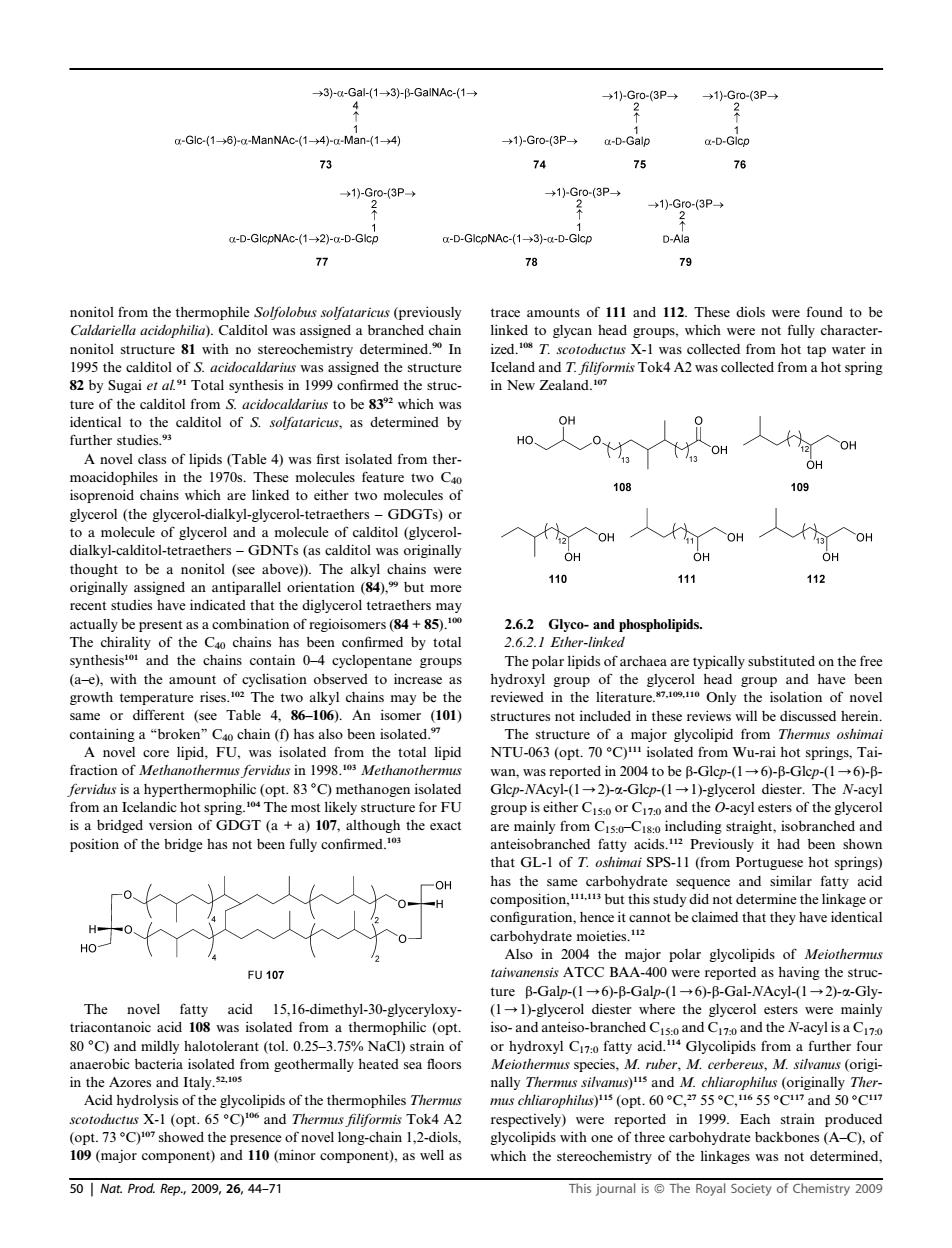正在加载图片...

→3Ga1-→3-GaINAc-(1- →10-G0-(3P→1Go(3P a-Glc(1->6)-a-ManNAc-(1->4)-a-Man-(1-4) →1)-Gro3pao-Gdp a-D-Gicp 73 74 75 76 →1-Go(3P →1-Gro-(3p →-o-3P w-D-GIcpNAc-(1-2)-u-O-Gkcp a-D-GICpNAc-(1-3)--D-Glcp 78 79 amounts of 111 and 112.These diols were found to be linked to glycan head groups,which were not fully character ture of the calditol from S.acidocaldarius to be 83which was dentcal to the calditol of s.as determined by HO A novel class of lipids (Table 4)was first isolated from ther moacidophiles in the 1970s.These molecules feature two C 108 10g ns wh OH dialkyl-calditol-tetraethers-GDNTs(as calditol was originally thought to be a nonito 11 85 ynthesist and the chains contain 04 evclopentaneg The polar lipids of archaea are typically substituted on the free hydroxyl group of the glycerol head group and have ber growtl may b nly An ontaining a“broken Cochain (f)has also beer ted The structure of a major glycolipid from Thermus oshima total lipid NTU-063 (opt.70C)isolated from Wu-rai hot springs,Tai- was sreported n B-Gicp-( 6P- eth Th the -acyl estr of the are mainly from C that GL-I of T.SPS-1 (from Portu X9 this study did not carbohydrate Also in2004 the major polar glycolipids of FU107 as ha ing me The novel fatty acid 15,16-dimethyl-30-glyceryloxy- (1-1-glycerol diester where the glycerol esters were mainly -and anteiso-branched C hydroxyl C laty nally Therm 4A3 )(opt.60 and opt.73showed the presence of novel ongchain -dio with one f three carbohvdrate backbones (AC).of 109(major component)and 110(minor component),as well as which the stereochemistry of the linkages was not determined. 501 Nat.Prod.Rep2009,26,44-71 This journal isThe Royal Society of Chemistry009 nonitol from the thermophile Solfolobus solfataricus (previously Caldariella acidophilia). Calditol was assigned a branched chain nonitol structure 81 with no stereochemistry determined.90 In 1995 the calditol of S. acidocaldarius was assigned the structure 82 by Sugai et al.91 Total synthesis in 1999 confirmed the structure of the calditol from S. acidocaldarius to be 8392 which was identical to the calditol of S. solfataricus, as determined by further studies.93 A novel class of lipids (Table 4) was first isolated from thermoacidophiles in the 1970s. These molecules feature two C40 isoprenoid chains which are linked to either two molecules of glycerol (the glycerol-dialkyl-glycerol-tetraethers – GDGTs) or to a molecule of glycerol and a molecule of calditol (glyceroldialkyl-calditol-tetraethers – GDNTs (as calditol was originally thought to be a nonitol (see above)). The alkyl chains were originally assigned an antiparallel orientation (84),99 but more recent studies have indicated that the diglycerol tetraethers may actually be present as a combination of regioisomers (84 + 85).100 The chirality of the C40 chains has been confirmed by total synthesis101 and the chains contain 0–4 cyclopentane groups (a–e), with the amount of cyclisation observed to increase as growth temperature rises.102 The two alkyl chains may be the same or different (see Table 4, 86–106). An isomer (101) containing a ‘‘broken’’ C40 chain (f) has also been isolated.97 A novel core lipid, FU, was isolated from the total lipid fraction of Methanothermus fervidus in 1998.103 Methanothermus fervidus is a hyperthermophilic (opt. 83 C) methanogen isolated from an Icelandic hot spring.104 The most likely structure for FU is a bridged version of GDGT (a + a) 107, although the exact position of the bridge has not been fully confirmed.103 The novel fatty acid 15,16-dimethyl-30-glyceryloxytriacontanoic acid 108 was isolated from a thermophilic (opt. 80 C) and mildly halotolerant (tol. 0.25–3.75% NaCl) strain of anaerobic bacteria isolated from geothermally heated sea floors in the Azores and Italy.52,105 Acid hydrolysis of the glycolipids of the thermophiles Thermus scotoductus X-1 (opt. 65 C)106 and Thermus filiformis Tok4 A2 (opt. 73 C)107 showed the presence of novel long-chain 1,2-diols, 109 (major component) and 110 (minor component), as well as trace amounts of 111 and 112. These diols were found to be linked to glycan head groups, which were not fully characterized.108 T. scotoductus X-1 was collected from hot tap water in Iceland and T. filiformis Tok4 A2 was collected from a hot spring in New Zealand.107 2.6.2 Glyco- and phospholipids. 2.6.2.1 Ether-linked The polar lipids of archaea are typically substituted on the free hydroxyl group of the glycerol head group and have been reviewed in the literature.87,109,110 Only the isolation of novel structures not included in these reviews will be discussed herein. The structure of a major glycolipid from Thermus oshimai NTU-063 (opt. 70 C)111 isolated from Wu-rai hot springs, Taiwan, was reported in 2004 to be b-Glcp-(1/6)-b-Glcp-(1/6)-bGlcp-NAcyl-(1/2)-a-Glcp-(1/1)-glycerol diester. The N-acyl group is either C15:0 or C17:0 and the O-acyl esters of the glycerol are mainly from C15:0–C18:0 including straight, isobranched and anteisobranched fatty acids.112 Previously it had been shown that GL-1 of T. oshimai SPS-11 (from Portuguese hot springs) has the same carbohydrate sequence and similar fatty acid composition,111,113 but this study did not determine the linkage or configuration, hence it cannot be claimed that they have identical carbohydrate moieties.112 Also in 2004 the major polar glycolipids of Meiothermus taiwanensis ATCC BAA-400 were reported as having the structure b-Galp-(1/6)-b-Galp-(1/6)-b-Gal-NAcyl-(1/2)-a-Gly- (1/1)-glycerol diester where the glycerol esters were mainly iso- and anteiso-branched C15:0 and C17:0 and the N-acyl is a C17:0 or hydroxyl C17:0 fatty acid.114 Glycolipids from a further four Meiothermus species, M. ruber, M. cerbereus, M. silvanus (originally Thermus silvanus) 115 and M. chliarophilus (originally Thermus chliarophilus) 115 (opt. 60 C,27 55 C,116 55 C117 and 50 C117 respectively) were reported in 1999. Each strain produced glycolipids with one of three carbohydrate backbones (A–C), of which the stereochemistry of the linkages was not determined, 50 | Nat. Prod. Rep., 2009, 26, 44–71 This journal is ª The Royal Society of Chemistry 2009